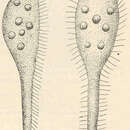fi
nimet breadcrumb-navigoinnissa


The stichotrichs were a proposed group of ciliates, in the class Spirotrichea. In a classification system proposed by Eugene Small and Denis Lynn in 1985, Stichotrichia formed a subclass containing four orders: Stichotrichida, Urostylida, Sporadotrichida and Plagiotomida.[1] Although the group was made up of species traditionally classified among the "hypotrichs"--ciliates possessing compound ciliary organelles called cirri--it excluded euplotid ciliates such as Euplotes and Diophrys, which were placed in the subclass Hypotrichia. In later classifications proposed by Denis Lynn, Stichotrichia omits the order Plagiotomida (species in that group were relocated to the order Stichotrichida).[2]
In more recent classifications, members of Stichotrichia, as defined by Small and Lynn., are placed in the subclass Hypotrichia, and euplotid ciliates are placed in the subclass Euplotia. [3][4]
Like the euplotids, stichotrichs (or hypotrichs, in the sense of Gao et al., 2016)[3] have body cilia fused into cirri, but these are mostly arranged into rows, running along the ventral surface or edges of the cell. Most stichotrichs are flattened and reasonably flexible, although some, such as Stylonychia, have rigid bodies. Characteristic genera include Stylonychia, Oxytricha, Uroleptus and Urostyla.
The term stichotrich derives from the ancient greek στίχος (stíkhos), meaning "row", and θρίξ, τριχός (thríx, trikhós), meaning 'hair',[5][6] because of the arrangement into rows of the cilia.
The draft macronuclear genome of Oxytricha trifallax was published in 2013.[7]
 Stichotricha secunda
Stichotricha secunda The stichotrichs were a proposed group of ciliates, in the class Spirotrichea. In a classification system proposed by Eugene Small and Denis Lynn in 1985, Stichotrichia formed a subclass containing four orders: Stichotrichida, Urostylida, Sporadotrichida and Plagiotomida. Although the group was made up of species traditionally classified among the "hypotrichs"--ciliates possessing compound ciliary organelles called cirri--it excluded euplotid ciliates such as Euplotes and Diophrys, which were placed in the subclass Hypotrichia. In later classifications proposed by Denis Lynn, Stichotrichia omits the order Plagiotomida (species in that group were relocated to the order Stichotrichida).
In more recent classifications, members of Stichotrichia, as defined by Small and Lynn., are placed in the subclass Hypotrichia, and euplotid ciliates are placed in the subclass Euplotia.
Like the euplotids, stichotrichs (or hypotrichs, in the sense of Gao et al., 2016) have body cilia fused into cirri, but these are mostly arranged into rows, running along the ventral surface or edges of the cell. Most stichotrichs are flattened and reasonably flexible, although some, such as Stylonychia, have rigid bodies. Characteristic genera include Stylonychia, Oxytricha, Uroleptus and Urostyla.
Los esticotricos (Stichotrichia) son un grupo de protistas del filo Ciliophora incluido en Spirotrichea. Como los hipotricos, con los que antiguamente fueron clasificados, presentan cilios fusionados en cirros, aunque estos se presentan principalmente localizados en filas, que corren sobre la superficie ventral o por los bordes de la célula. La mayoría de los esticotricos son aplanados y razonablemente flexibles. Géneros representativos son Stylonychia y Oxytricha. Algunos estudios sugieren que Hypotrichia puede ser parafilético a Stichotrichia, y que éste a su vez puede ser parafilético a Oligotrichia.
Los esticotricos (Stichotrichia) son un grupo de protistas del filo Ciliophora incluido en Spirotrichea. Como los hipotricos, con los que antiguamente fueron clasificados, presentan cilios fusionados en cirros, aunque estos se presentan principalmente localizados en filas, que corren sobre la superficie ventral o por los bordes de la célula. La mayoría de los esticotricos son aplanados y razonablemente flexibles. Géneros representativos son Stylonychia y Oxytricha. Algunos estudios sugieren que Hypotrichia puede ser parafilético a Stichotrichia, y que éste a su vez puede ser parafilético a Oligotrichia.
Stichotrichler bir grup silli organizma.
Stichotrich eski yunanca anlamı 'kürek çekme' olan στίχος (stíkhos) ve 'saç' anlamına gelen θρίξ, τριχός (thríks, trikhós ) kelimelerinden türemiştir.[1][2]
Oxytricha trifallax 'ın taslak macronükleer genomu 2013 yılında yayınlanmıştır.[3]
Stichotrichler bir grup silli organizma.